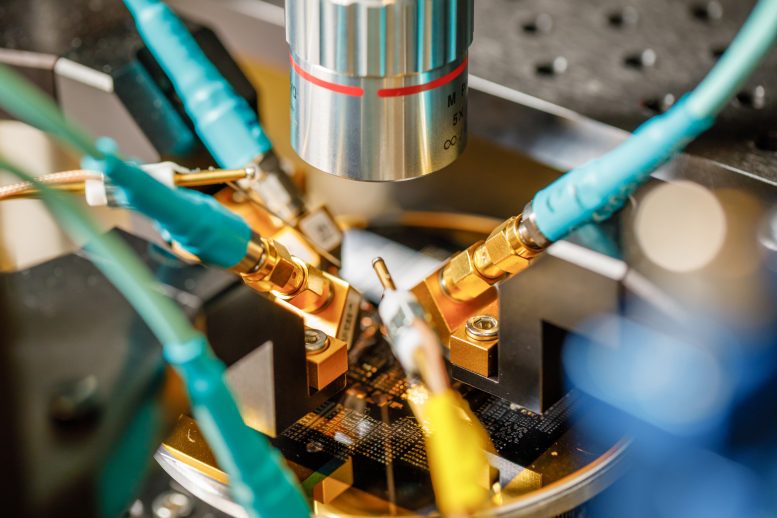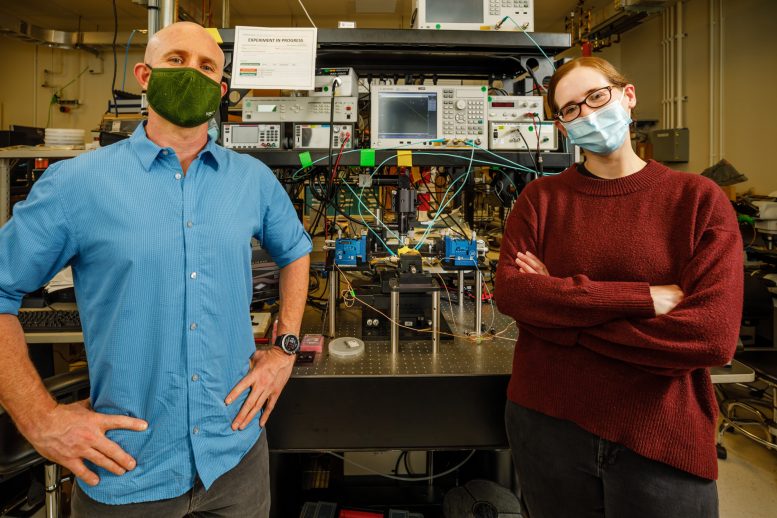
Matt Eichenfield’s team at Sandia National Laboratories uses multiple microwave frequencies to characterize a nonlinear phononic mixing device they built on a silicon wafer. Credit: Bret Latter/Sandia National Laboratories
What if your earbuds could do everything your smartphone can do already, except better? What sounds a bit like science fiction may actually not be so far off. A new class of synthetic materials could herald the next revolution of wireless technologies, enabling devices to be smaller, require less signal strength, and use less power.
The key to these advances lies in what experts call phononics, which is similar to photonics. Both take advantage of similar physical laws and offer new ways to advance technology. While photonics takes advantage of photons – or light – phononics does the same with phonons, which are the physical particles that transmit mechanical vibrations through a material, akin to sound, but at frequencies much too high to hear.
In a paper published in Nature Materials, researchers at the University of Arizona Wyant College of Optical Sciences and Sandia National Laboratories report clearing a major milestone toward real-world applications based on phononics. By combining highly specialized semiconductor materials and piezoelectric materials not typically used together, the researchers were able to generate giant nonlinear interactions between phonons. Together with previous innovations demonstrating amplifiers for phonons using the same materials, this opens up the possibility of making wireless devices such as smartphones or other data transmitters smaller, more efficient, and more powerful.
Technology Inside Smartphones
“Most people would probably be surprised to hear that there are something like 30 filters inside their cell phone whose sole job it is to transform radio waves into sound waves and back,” said the study’s senior author, Matt Eichenfield, who holds a joint appointment at the UArizona College of Optical Sciences and Sandia National Laboratories in Albuquerque, New Mexico.
Part of what are known as front-end processors, these piezoelectric filters, made on special microchips, are necessary to convert sound and electronic waves multiple times each time a smartphone receives or sends data, he said. Because these can’t be made out of the same materials, such as silicon, as the other critically important chips in the front-end processor, the physical size of your device is much bigger than it needs to be, and along the way, there are losses from going back and forth between radio waves and sound waves that add up and degrade the performance, Eichenfield said.

Matt Eichenfield, left, and Lisa Hackett, pictured in their lab at Sandia National Laboratories during the COVID-19 pandemic. Building on previous research, the team now has produced acoustic mixers, completing the list of components needed to make a radio frequency front end on a single chip. Credit: Bret Latter/Sandia National Laboratories
“Normally, phonons behave in a completely linear fashion, meaning they don’t interact with each other,” he said. “It’s a bit like shining one laser pointer beam through another; they just go through each other.”
Nonlinear phononics refers to what happens in special materials when the phonons can and do interact with each other, Eichenfield said. In the paper, the researchers demonstrated what he calls “giant phononic nonlinearities.” The synthetic materials produced by the research team caused the phonons to interact with each other much more strongly than in any conventional material.
“In the laser pointer analogy, this would be like changing the frequency of the photons in the first laser pointer when you turn on the second,” he said. “As a result, you’d see the beam from the first one changing color.”
With the new phononics materials, the researchers demonstrated that one beam of phonons can, in fact, change the frequency of another beam. What’s more, they showed that phonons can be manipulated in ways that could only be realized with transistor-based electronics – until now.
Advancements Towards Single-Chip Solutions
The group has been working toward the goal of making all of the components needed for radio frequency signal processors using acoustic wave technologies instead of transistor-based electronics on a single chip, in a way that’s compatible with standard microprocessor manufacturing, and the latest publication proves that it can be done. Previously, the researchers succeeded in making acoustic components including amplifiers, switches, and others. With the acoustic mixers described in the latest publication, they have added the last piece of the puzzle.
“Now, you can point to every component in a diagram of a radiofrequency front-end processor and say, ‘Yeah, I can make all of these on one chip with acoustic waves,’” Eichenfield said. “We’re ready to move on to making the whole shebang in the acoustic domain.”
Having all the components needed to make a radio frequency front end on a single chip could shrink devices such as cell phones and other wireless communication gadgets by as much as a factor of a 100, according to Eichenfield.
The team accomplished its proof of principle by combining highly specialized materials into microelectronics-sized devices through which they sent acoustic waves. Specifically, they took a silicon wafer with a thin layer of lithium niobate – a synthetic material used extensively in piezoelectronic devices and cell phones – and added an ultra-thin layer (fewer than 100 atoms thick) of a semiconductor containing indium gallium arsenide.
“When we combined these materials in just the right way, we were able to experimentally access a new regime of phononic nonlinearity,” said Sandia engineer Lisa Hackett, the lead author on the paper. “This means we have a path forward to inventing high-performance tech for sending and receiving radio waves that’s smaller than has ever been possible.”
In this setup, acoustic waves moving through the system behave in nonlinear ways when they travel through the materials. This effect can be used to change frequencies and encode information. A staple of photonics, nonlinear effects have long been used to make things like invisible laser light into visible laser pointers, but taking advantage of nonlinear effects in phononics has been hindered by limitations in technology and materials. For example, while lithium niobate is one of the most nonlinear phononic materials known, its usefulness for technical applications is hindered by the fact that those nonlinearities are very weak when used on its own.
By adding the indium-gallium arsenide semiconductor, Eichenfield’s group created an environment in which the acoustic waves traveling through the material influence the distribution of electrical charges in the indium-gallium arsenide semiconductor film, causing the acoustic waves to mix in specific ways that can be controlled, opening up the system to various applications.
“The effective nonlinearity you can generate with these materials is hundreds or even thousands of times larger than was possible before, which is crazy,” Eichenfield said. “If you could do the same for nonlinear optics, you would revolutionize the field.”
With physical size being one of the fundamental limitations of current, state-of-the-art radiofrequency processing hardware, the new technology could open the door to electronic devices that are even more capable than their current counterparts, according to the authors. Communication devices that take virtually no space, have better signal coverage, and have longer battery life, are on the horizon.
Reference: “Giant electron-mediated phononic nonlinearity in semiconductor–piezoelectric heterostructures” by Lisa Hackett, Matthew Koppa, Brandon Smith, Michael Miller, Steven Santillan, Scott Weatherred, Shawn Arterburn, Thomas A. Friedmann, Nils Otterstrom and Matt Eichenfield, 3 May 2024, Nature Materials.DOI: 10.1038/s41563-024-01882-4
The study was funded by the Defense Advanced Research Projects Agency and the US Department of Energy.
Source: SciTechDaily